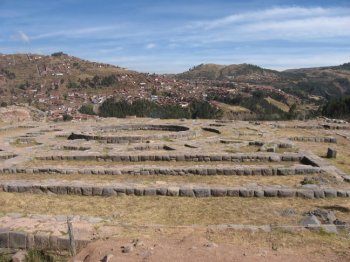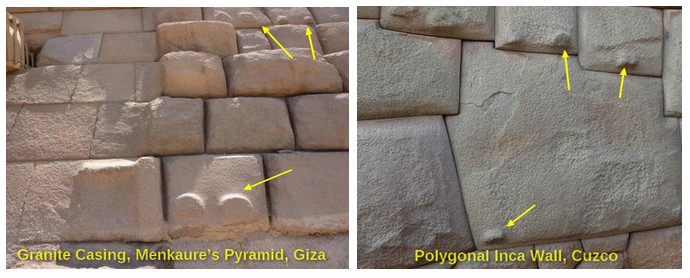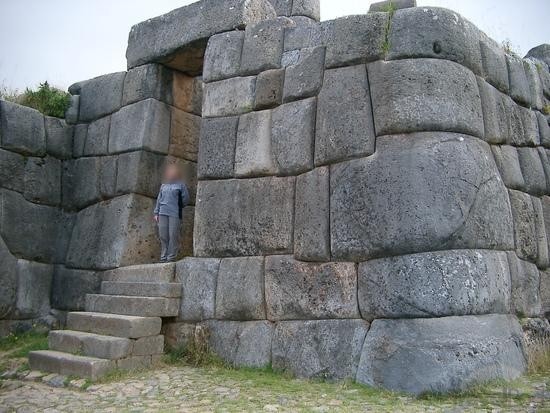It looks like you're using an Ad Blocker.
Please white-list or disable AboveTopSecret.com in your ad-blocking tool.
Thank you.
Some features of ATS will be disabled while you continue to use an ad-blocker.
share:
a reply to: jeep3r
I've looked into this doc: docs.google.com...
The translation seems to be correct.
Page 33:
During the ground-penetrating radar investigation, experts from Geo & Asociados SRL noticed considerable surface erosion of the stone blocks. A basic analysis has been done on site. Two samples placed into acidic environment (vinegar) dissolved within hours.
Pages 34-36:
They suggest a chemical analysis of rain water in the area, and recommend a protective coating of the stones, if the rain is shown to be acidic.
Pages 45-50:
Microcrystalline limestone without organic residues/fragments.
Pages 51-52
Microcrystalline limestone with fissures and recrystallization (to marble).
Pages 53-55:
Samples of limestone with organic residues (organogenic).
Following pages show more samples microcrystalline limestone.
Page 72:
Sample from the quarry shows organogenic limestone.
Page 75:
Chemical composition of the quarry and the wall samples.
I've looked into this doc: docs.google.com...
The translation seems to be correct.
Page 33:
During the ground-penetrating radar investigation, experts from Geo & Asociados SRL noticed considerable surface erosion of the stone blocks. A basic analysis has been done on site. Two samples placed into acidic environment (vinegar) dissolved within hours.
Pages 34-36:
They suggest a chemical analysis of rain water in the area, and recommend a protective coating of the stones, if the rain is shown to be acidic.
Pages 45-50:
Microcrystalline limestone without organic residues/fragments.
Pages 51-52
Microcrystalline limestone with fissures and recrystallization (to marble).
Pages 53-55:
Samples of limestone with organic residues (organogenic).
Following pages show more samples microcrystalline limestone.
Page 72:
Sample from the quarry shows organogenic limestone.
Page 75:
Chemical composition of the quarry and the wall samples.
edit on 8-5-2016 by moebius because: (no reason given)
a reply to: punkinworks10
I certainly won't often dispute you....
www.terrapub.co.jp...
Its not "plant juice" insomuch as a various group of compounds that some plants produce.
I certainly won't often dispute you....
www.terrapub.co.jp...
Its not "plant juice" insomuch as a various group of compounds that some plants produce.
So what happened to the plant?
It was last seen in the early 1900's?
It was last seen in the early 1900's?
Greetings,
Check " bionic soils "
I think you'll get your answer there.
Check " bionic soils "
I think you'll get your answer there.
This is a total non starter isn't it. In the video the geologists claim they took a sample of the wall and it was limestone, when its well known the
wall is Andesite
so you have
1. the wall is made of soft limestone, explaining easily the complicated cuts
2. The wall is made of Andesite and the geologists are idiots and their claims are nonsense
either way, where is the mystery ?
so you have
1. the wall is made of soft limestone, explaining easily the complicated cuts
2. The wall is made of Andesite and the geologists are idiots and their claims are nonsense
either way, where is the mystery ?
originally posted by: Marduk
1. the wall is made of soft limestone, explaining easily the complicated cuts
2. The wall is made of Andesite and the geologists are idiots and their claims are nonsense
either way, where is the mystery?
Regarding your last question: the results indicate the use of reconstituted limestone with a different micro-crystalline structure than natural limestone (which could be considered a mystery).
As for the rest of your comment: see here for the diverse material composition of the wall and here for the samples they took (including the results).
You may of course send an email to the deputy director (Institute of Tectonics & Geophysics, Khabarovsk) and tell him that you think what they analyzed is andesite. In that case don't forget to let me know what he replied.
originally posted by: Marduk
This is a total non starter isn't it. In the video the geologists claim they took a sample of the wall and it was limestone, when its well known the wall is Andesite
so you have
1. the wall is made of soft limestone, explaining easily the complicated cuts
2. The wall is made of Andesite and the geologists are idiots and their claims are nonsense
either way, where is the mystery ?
Here is another source stating that it is locally-quarried limestone:
www.naturstein-institut.de...
www.naturstein-institut.de...
In many descriptions of the location, false descriptions of the stones are adopted repeatedly. You see, these are not granites, andesites, diorites or the like, but its limestone of the Sangarara formation of the upper cretaceous system. Even in the geological map of Cuzco, the mapping of the outcropping stones is not correct. This might be the reason why the limestone is often described as a magmatic stone. Diorite, outcropping in the basal part of the limestone, shows only in the zone of the Inca throne out of the limestone almost like an island.
originally posted by: punkinworks10
Why am i the only person who has seen the 800lb elephant in the room?
That elephant, is the fact that the stone work at Sacsayhuaman,
is ANDESITE, its not limestone, so the whole premise is moot.
No amount of "PLANT JUICE" is going to soften that rock, and if the cant tell the difference he is a pretty terrrible geologist and or chemist.
No problem, punkinworks. A few posts above you a guy is claiming the AEs could "reconstitute" granite.
So "reconstituted" andesite isn't beyond these peoples' belief system.
Harte
Sacsayhuaman limestone foundation:
originally posted by: jeep3r
a reply to: punkinworks10
There's a section about the different rock types of Sacsayhuaman in Lost Civilisations of the Andes by David Pratt:
Various types of rock were used, including massive diorite blocks from nearby for the outer walls, Yucay limestone from more than 15 km away for the foundations, and a dark andesite, some from over 30 km away, for the inner buildings.

So closely fitted!! Ooh! Aah!
Sacsayhuaman andesite walls:

Harte
originally posted by: Harte
No problem, punkinworks. A few posts above you a guy is claiming the AEs could "reconstitute" granite.
So "reconstituted" andesite isn't beyond these peoples' belief system.
Harte
Just had a good laugh, Harte!
But on a more serious note: it wasn't a claim, I said I wouldn't be surprised if someone found this to be the case upon further analysis. Slight difference.
And I think you know why I was referring to Menkaure's granite casing.
originally posted by: jeep3r
originally posted by: Harte
No problem, punkinworks. A few posts above you a guy is claiming the AEs could "reconstitute" granite.
So "reconstituted" andesite isn't beyond these peoples' belief system.
Harte
And I think you know why I was referring to Menkaure's granite casing.
For a joke, I would hope.
Harte
a reply to: Harte
Linky (see last 2 images)
Because there's a striking similarity in the details of the stone work across continents and cultures. Here's another example. But that would probably be something for another thread...
Linky (see last 2 images)
Because there's a striking similarity in the details of the stone work across continents and cultures. Here's another example. But that would probably be something for another thread...
edit on 8-5-2016 by jeep3r because: fixed link
originally posted by: moebius
a reply to: jeep3r
I've looked into this doc: docs.google.com...
The translation seems to be correct.
Page 33:
During the ground-penetrating radar investigation, experts from Geo & Asociados SRL noticed considerable surface erosion of the stone blocks. A basic analysis has been done on site. Two samples placed into acidic environment (vinegar) dissolved within hours.
The translation is incorrect, unless those are very small limestone fragments.
Try it for yourself: get some limestone and put it in vinegar. Wait till it dissolves.
(your wait will be several days to "never" if there's enough limestone... because the Calcium carbonate neutralizes acid. And yes, I know this because I used vinegar AND lime remover to remove limestone on very delicate fossils. Vinegar or glacial acetic acid (dangerous stuff) does work but it's a lot slower than grinding it off by hand.)
originally posted by: jeep3r
a reply to: Harte
Linky (see last 2 images)
Because there's a striking similarity in the details of the stone work across continents and cultures. Here's another example. But that would probably be something for another thread...
Ah. So, a joke.
Harte
Another flaw in this theory is visible in the photos in the OP: the notches along the bottom of the blocks were used to hold logs to support the
weight of the block while they were scribed to the shape of the adjoining blocks.

Hardly needed if they could dissolve/reconstitute them.

Hardly needed if they could dissolve/reconstitute them.
a reply to: Blackmarketeer
If that were the case, then they didn't apply the method consistently. Below we see wall segments that didn't need those notches:

In this example, the notches aren't consistent with the angles one would expect to see when using the method shown in your image (and it's a rather small block).
Yet other blocks have bosses instead of notches:

...and they don't seem to be there for the purpose of friction/ropes (some have them, others don't). Apart from that it's hardly believable that they just scraped away material until only the bosses were left.
Sorry, but your textbook diagram doesn't explain it for me.
If that were the case, then they didn't apply the method consistently. Below we see wall segments that didn't need those notches:

In this example, the notches aren't consistent with the angles one would expect to see when using the method shown in your image (and it's a rather small block).
Yet other blocks have bosses instead of notches:

...and they don't seem to be there for the purpose of friction/ropes (some have them, others don't). Apart from that it's hardly believable that they just scraped away material until only the bosses were left.
Sorry, but your textbook diagram doesn't explain it for me.
a reply to: jeep3r
You pointed out the bosses on some blocks as well, which also indicated these were solid blocks lifted into place and not "reconstituted." Bosses, coins, notches, are all indications of a solid block being shaped and lifted into place. There is no other reason for these features to be present. They are not always present on every block because 1) smaller blocks can be handled without them, and 2) the faces were abraded to remove them.
Another feature being ignored by the "reconstituted" theory is that these blocks only fit 'perfectly' along their front (exposed) edge. The back edge is full of gaps and relied on a filler material to keep the blocks fitted.

The blocks were 'wedge shaped' and were only precisely scribed and coped to fit tightly along their leading edge. A "poured" block (not that there ever was such a thing) would not be wedge shaped and would conform to adjoining "poured" blocks uniformly along it's entire width and not only the leading edge.
You pointed out the bosses on some blocks as well, which also indicated these were solid blocks lifted into place and not "reconstituted." Bosses, coins, notches, are all indications of a solid block being shaped and lifted into place. There is no other reason for these features to be present. They are not always present on every block because 1) smaller blocks can be handled without them, and 2) the faces were abraded to remove them.
Another feature being ignored by the "reconstituted" theory is that these blocks only fit 'perfectly' along their front (exposed) edge. The back edge is full of gaps and relied on a filler material to keep the blocks fitted.

The blocks were 'wedge shaped' and were only precisely scribed and coped to fit tightly along their leading edge. A "poured" block (not that there ever was such a thing) would not be wedge shaped and would conform to adjoining "poured" blocks uniformly along it's entire width and not only the leading edge.
a reply to: Blackmarketeer
Nice theory, although not new. However, other parts of the walls show the same precision fitting along the entire length of the blocks:

And I still don't see why this relatively small block needed eight notches. But I'm sure there's a diagram explaining that too.
Nice theory, although not new. However, other parts of the walls show the same precision fitting along the entire length of the blocks:

And I still don't see why this relatively small block needed eight notches. But I'm sure there's a diagram explaining that too.
Mayāsura was renowned for his architectural abilities. It is said he ruled over MayaRastra (present day Meerut in India). It was believed that Mayāsura and his people could even melt stones for constructing their great architectural wonders.
en.wikipedia.org...
a reply to: jeep3r
It's not a theory, this is what archaeologists have found when portions of the walls have been disassembled. Where the blocks were seen from the front only, those blocks were wedged shaped to make it easier for scribing.
IF they had the technology to 'mold' the stone, then there would be no need for the examples of stone-working we see - bosses, coins, notches for posts - all necessary for manhandling the blocks into position, and wedge-shapes to allow for scribing, etc.
It's not a theory, this is what archaeologists have found when portions of the walls have been disassembled. Where the blocks were seen from the front only, those blocks were wedged shaped to make it easier for scribing.
IF they had the technology to 'mold' the stone, then there would be no need for the examples of stone-working we see - bosses, coins, notches for posts - all necessary for manhandling the blocks into position, and wedge-shapes to allow for scribing, etc.
new topics
-
This is our Story
General Entertainment: 1 hours ago -
President BIDEN Vows to Make Americans Pay More Federal Taxes in 2025 - Political Suicide.
2024 Elections: 3 hours ago -
Ode to Artemis
General Chit Chat: 4 hours ago -
Ditching physical money
History: 7 hours ago -
One Flame Throwing Robot Dog for Christmas Please!
Weaponry: 7 hours ago -
Don't take advantage of people just because it seems easy it will backfire
Rant: 8 hours ago -
VirginOfGrand says hello
Introductions: 8 hours ago -
Should Biden Replace Harris With AOC On the 2024 Democrat Ticket?
2024 Elections: 9 hours ago -
University student disciplined after saying veganism is wrong and gender fluidity is stupid
Education and Media: 11 hours ago
top topics
-
Hate makes for strange bedfellows
US Political Madness: 17 hours ago, 20 flags -
University student disciplined after saying veganism is wrong and gender fluidity is stupid
Education and Media: 11 hours ago, 12 flags -
Police clash with St George’s Day protesters at central London rally
Social Issues and Civil Unrest: 14 hours ago, 9 flags -
President BIDEN Vows to Make Americans Pay More Federal Taxes in 2025 - Political Suicide.
2024 Elections: 3 hours ago, 8 flags -
TLDR post about ATS and why I love it and hope we all stay together somewhere
General Chit Chat: 15 hours ago, 7 flags -
Should Biden Replace Harris With AOC On the 2024 Democrat Ticket?
2024 Elections: 9 hours ago, 6 flags -
Don't take advantage of people just because it seems easy it will backfire
Rant: 8 hours ago, 4 flags -
One Flame Throwing Robot Dog for Christmas Please!
Weaponry: 7 hours ago, 4 flags -
God lived as a Devil Dog.
Short Stories: 13 hours ago, 3 flags -
Ditching physical money
History: 7 hours ago, 3 flags
active topics
-
Who guards the guards
US Political Madness • 5 • : 19Bones79 -
One Flame Throwing Robot Dog for Christmas Please!
Weaponry • 6 • : BeTheGoddess2 -
Police clash with St George’s Day protesters at central London rally
Social Issues and Civil Unrest • 37 • : SprocketUK -
New whistleblower Jason Sands speaks on Twitter Spaces last night.
Aliens and UFOs • 48 • : baablacksheep1 -
Russia Ukraine Update Thread - part 3
World War Three • 5718 • : Freeborn -
Hate makes for strange bedfellows
US Political Madness • 40 • : 19Bones79 -
Lawsuit Seeks to ‘Ban the Jab’ in Florida
Diseases and Pandemics • 29 • : Cre8chaos79 -
TLDR post about ATS and why I love it and hope we all stay together somewhere
General Chit Chat • 8 • : Cre8chaos79 -
This is our Story
General Entertainment • 0 • : BrotherKinsMan -
British TV Presenter Refuses To Use Guest's Preferred Pronouns
Education and Media • 126 • : Asher47
